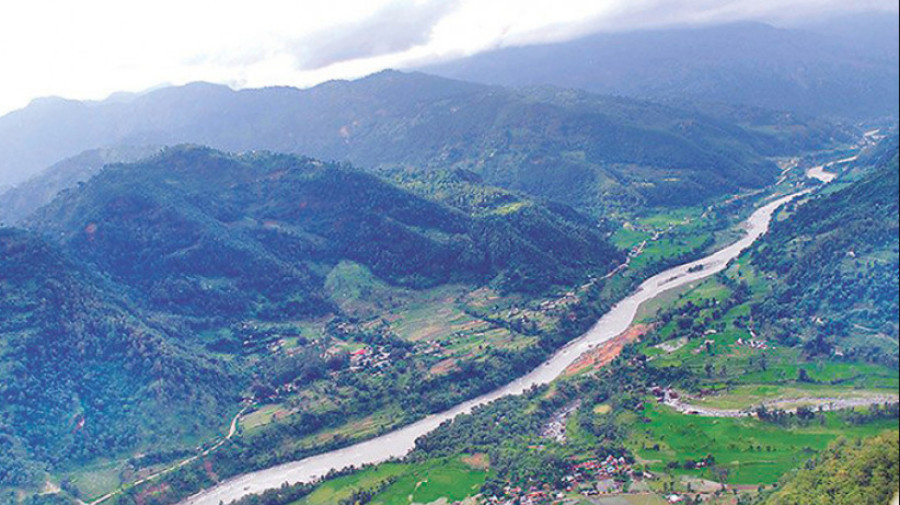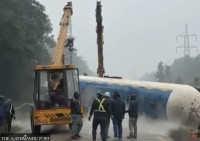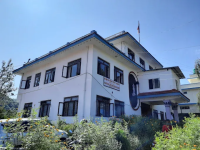National
Policy inconsistency delays Budhi Gandaki project
The government appears prepared to award the 1,200 MW project to the Nepal Electricity Authority again after a gap of 11 years.
Prithvi Man Shrestha
After many trials and errors for over a decade, the government appears to have reached a conclusion that no company is better placed than the Nepal Electricity Authority to develop the 1200MW Budhi Gandaki Hydropower Project.
The government is now prepared to give a majority stake to the Nepal Electricity Authority (NEA) in the Budhi Gandaki Jalavidyut Public Limited, the company set up for developing the country’s largest storage-type project.
“There has been a discussion at the Energy Ministry about developing the project with the NEA having a majority stake in the Budhi Gandaki Jalvidhyut Public Limited,” Kul Man Ghising, managing director of the Nepal Electricity Authority, told the Post.
The government had established the company in September last year to develop the storage-type power project.
The company is yet to come into operation since the government has not provided a budget needed for acquiring the approval from the Office of the Company Registrar. The company was to explore resources after getting the approval to start work.
A senior official of the Energy Ministry said Pradeep Kumar Thike, deputy managing director of the NEA, is being considered for the role of chief executive officer of the new company. Before that a task force will be formed to work out the share structure of the new company, the official said.
The government is set to give the state utility, NEA, a leading role for developing the national pride project given that no other entity in the country has the experience of undertaking such mega projects.
“As the NEA has the technical expertise for developing big projects, there has been discussion on giving the state-owned utility the leading role to develop this project,” Dinesh Ghimire, secretary at the Energy Ministry, told the Post in a recent interview.
The project is also important from the perspective of energy security. Except for Kulekhani, all other power projects in operation are run-of-the-river type undertakings whose capacity declines to as low as 40 percent in the dry season.
Currently, Kulekhani I, Kulekhani II and Kulekhani III are the only storage type projects generating electricity in the country. Their combined capacity stands at 106MW.
Because of the dominance of the run-of-the-river type projects, Nepal has been forced to buy electricity from India during winter even though the country has an energy surplus in summer. Nepal’s total installed capacity has reached 2,650MW, according to the NEA.
The energy ministry official said that Budhi Gandaki became the victim of policy inconsistency in the past decade though it is ready with a detailed project report and land acquisition is almost completed. The government has already spent over Rs42 billion paying compensation for the acquisition of land.
Over the past decade, the government tried several modalities for developing the project, only to make it more uncertain.
In 1984, the government carried out a prefeasibility study of the project. The study concluded that the project has a high energy potential, large storage volume, and favourable location and access in central Nepal near the main load centre.
But the project did not move ahead. After a hiatus of 26 years, the NEA in the fiscal year 2010-11 carried out additional studies including identification of alternative locations for the project facilities/structures with a view to achieving optimum utilisation of the hydropower potential of the project site. The Energy Ministry also issued a license to the NEA in 2011, permitting it to survey the project.
Then the NEA in December 2012 selected a French-Nepali joint venture TRACTEBEL Engineering SA France and JADE Consult (Pvt) Ltd Nepal for conducting the feasibility study and preparing a detailed design of the project.
One of Nepal's most talked-about projects has been pulled back and forth by successive governments, preventing it from taking off for decades.
The government led by Baburam Bhattarai in 2012 decided to construct the project through an autonomous ‘development committee’.
In late 2015, the French company submitted its report proposing to develop Budhigandaki into a 1,200MW project with six Francis turbines each of 200 megawatts.
In 2017, the then Pushpa Kamal Dahal-led government awarded a contract to build the project without competitive bidding to China Gezhouba Group Corporation (CGGC) under the engineering, procurement, construction and financing (EPCF) modality.
The decision to award the contract to the Chinese developer was cancelled by the then Sher Bahadur Deuba government in November 2017, saying some procedural flaws had been made while awarding the contract.
Again in September 2018, the project got engulfed in politicking. The then KP Sharma Oli administration again decided to rope in the Chinese company, reverting the Deuba government’s decision to develop the project with internal resources.
But in April last year, the Sher Bahadur Deuba administration again decided to revoke the licence issued to the CGGC. Then the government announced that the project would be built by mobilising domestic resources. The project cost was estimated at $2.59 billion, according to a detailed feasibility study.
But officials say the exact cost of the project could increase sharply due to inflation. Subsequently, a company was established in September last year to develop the project.
But generating necessary resources to develop the project will be a daunting challenge. The committee led by Swarnim Wagle, the then vice-chair of National Planning Commission, had suggested that the government develop the project on its own by providing gap funding covering around one-third of the project development cost. A Cabinet meeting during the Deuba administration approved the committee's report and agreed to fund the shortfall. But the plan never materialised as the government fell before the decision could be formalised.
In its report, the committee said the government could cover the cost of land acquisition and the resettlement of the displaced families which could total as high as Rs94 billion.
According to the report, a significant chunk of the resources can be gathered through self-financing by government institutions. An infrastructure tax being imposed on imported fuel could be an important source of revenue that could be used to develop the project, the report added.
“As much as Rs164 billion could be collected by the fiscal year 2026-2027, based on an increase in petroleum consumption by 10 percent a year,” the report said. But the estimated tax collection is based on Rs5 per litre infrastructure/carbon tax that the government has been imposing since 2015.
In the fiscal year 2018-2019, then-finance minister Yuba Raj Khatiwada changed the name of the heading to ‘infrastructure development tax’. The tax was also raised to Rs10 per litre on the petroleum products and it is being charged even now. In September last year, the Nepal Oil Corporation had said that it had collected nearly Rs100 billion in infrastructure tax.
Ghising said that the NEA could also raise funds through public offering of project shares.




 11.12°C Kathmandu
11.12°C Kathmandu













%20(1).jpg&w=300&height=200)

